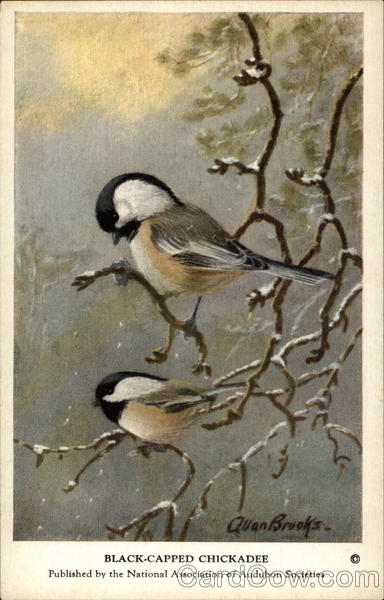Front:
QuanBruoks-
BLACK-CAPPED CHICKADEE
Published by the National Association of Audubon Societies
Back:
No. 46 Chickadee
Length 544 inches
This stout-hearted little braver of winter storms
is a general favorite. Indeed, many regard him
as their closest friend among birds.
When Warblers and Swallows and Thrushes
have left us, and frost and snow possess the land,
the Chickadee comes into his kingdom. His saucy
notes ring out in the bleak winter woods and bid
us be of good cheer. He comes about our homes,
performing his acrobatic feats in the trees of the
lawn, and is among the Grst to find the feeding-
shelf and the lump of suct on the trunk. At such
times his friendly social qualities are the delight
of all.
It is doubtful if any bicdus proportionately
more useful to man that this fittle member of the
Titmouse family, for he is a great destroyer of
insects which are harmful to grees. Even during
the winter more than one half of his food con-
sists of insects and their egg. It has been esti-
mated that one Chickadeenay destroy over one
hundred thousand eggs of the canker worm within
twenty-five days.
The nest is in holes in trees, old stumps, and
situations of similar character. It is composed of
grasses, moss, feathers and other soft material.
From five to nine eggs are laid, speckled chiefly at
the larger end with brown.
Classification: Order Passeres. Family Paride.
Scientific name: Panthestes atricapillus.
Range: Throughout the eastern and northern United
States and Canada.
No. 46 from set of 50 Winter Birds of the Northeastern United
States. Published by the National Association of Audubon So-
cieties, 1974 Broadway, New York City. Price per set, in a box,
$1.00 post paid.



